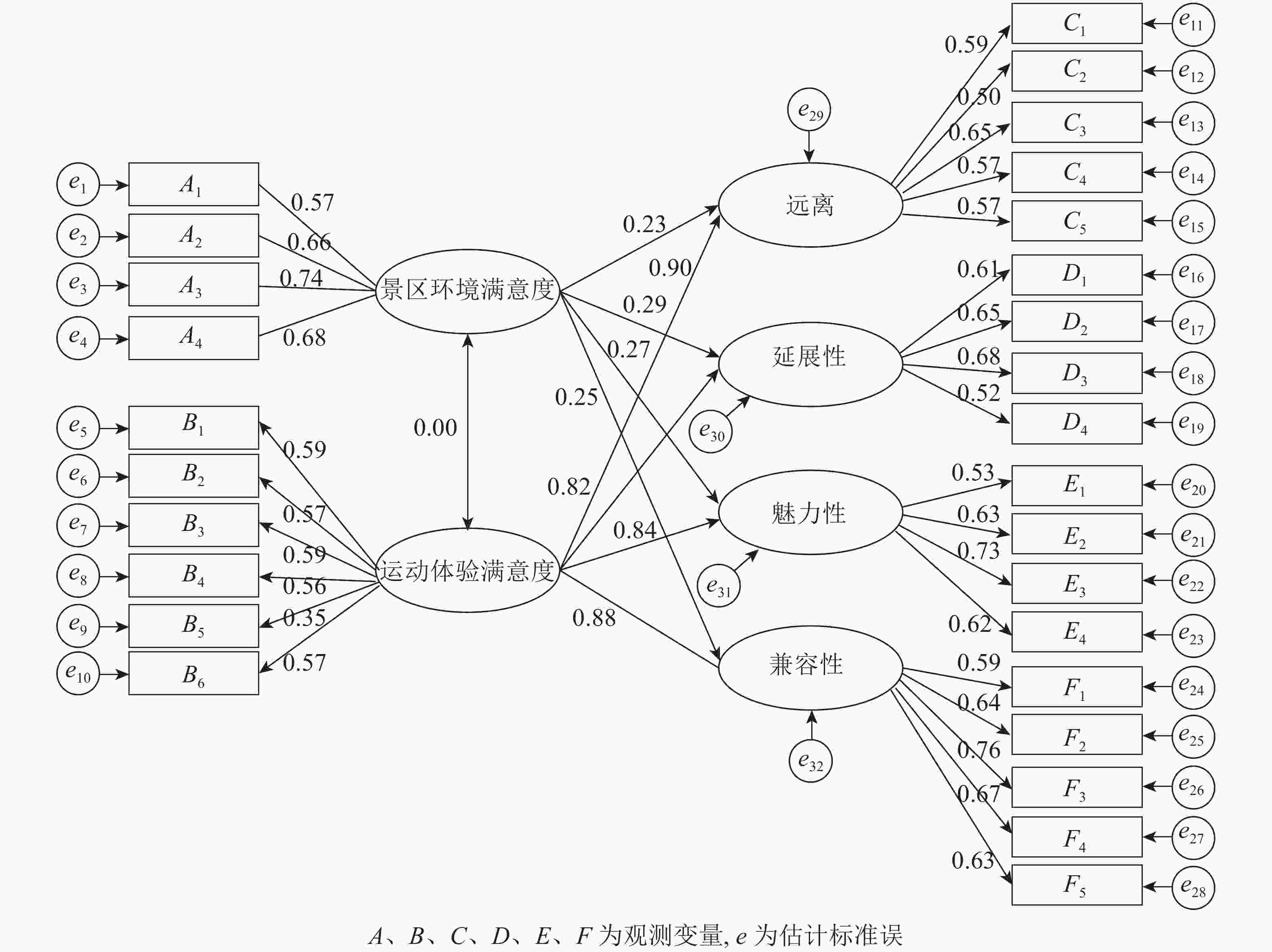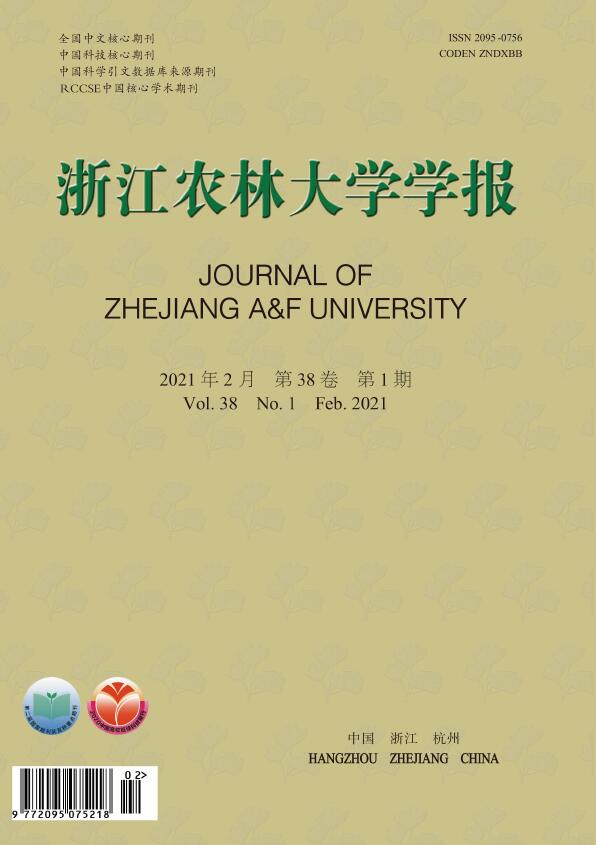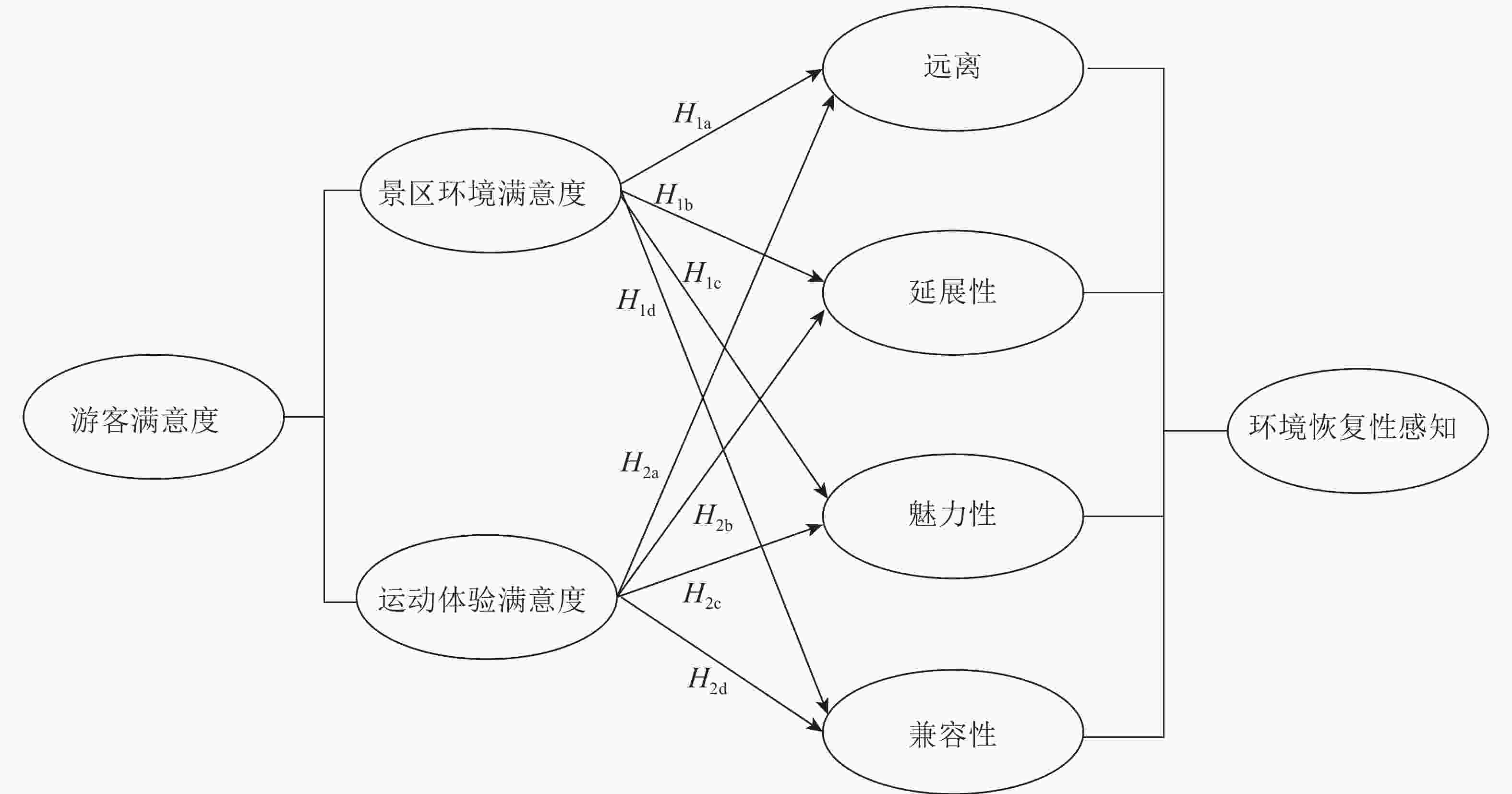-
随着城市现代化的推进,城市居民生活中的诸多不健康行为,导致身体疲惫与精神压力问题日益严重。在压力繁重的今天,人们为了纾解压力前往户外进行休闲游憩,以得到休息并促进身心健康[1]。目前,逐渐兴起的森林运动旅游,正是从森林环境的康养保健功能出发,结合运动项目,为城市居民提供休闲游憩、运动健身、康复疗养等活动的新兴旅游业态。旅游对纾解生活压力与精神疲劳有较好结果。KAPLAN等[2]率先开展环境恢复性研究,提出了注意力恢复理论和环境恢复性的维度。此后,该理论便成为学界的研究基础框架。目前,关于环境恢复性的研究热点主要集中于研究方法的探索和量表的开发。HARTIG等[3]基于KAPLAN等[2]的理论进一步研究开发了感知恢复量表(PRS)。PRS能以人的主观角度探究环境的恢复性效应,因而在相关学术领域应用广泛。如WANG等[4]运用PRS探究上海多个公园的游客恢复性感知。此后经过一些研究发现:PRS量表存在诸多问题,因而进行了一系列修正改良[5-7]。中国关于PRS的研究多采用黄章展等[8]改良后的适用于中国环境的量表。目前,在研究环境恢复性的影响因素方面已有较多成果,主要集中在研究环境恢复性的客观影响因素,如环境、气候等[9-11]。大量研究证明:环境质量的好坏能够影响人的环境恢复性感知,这也是目前相关研究的主要方向。如GRAHN等[12]通过研究发现:人对自然环境的感知与人类健康之间存在着联系。PESCHARDT等[13]发现:城市中建筑密集区的绿地对人的心理恢复有着积极的影响。在游憩体验过程中,人的感受不但取决于客观环境,也受其他因素(如活动、心理等)影响。郑群明等[14]发现:亚健康旅游者的运动体验对身体的健康恢复有正向影响。李昌俊等[15]发现:锻炼有益于人际关系与心理健康的发展。已有研究表明:游客的环境恢复性感知能够影响其对环境的满意度、喜好等方面[16]。因而在研究环境恢复性感知时,不但要考虑客观因素影响,还应从人的主观角度剖析其对环境恢复性的影响。游客的运动体验为环境恢复性感知的重要影响因素,目前还基本没有研究。同时,研究环境与运动满意度对游客环境恢复性感知的关系,可以探究环境因素与运动体验对游客环境恢复性感知的影响程度区别。森林运动作为新兴的康养旅游模式,还缺乏对其环境恢复性的相关研究。本研究通过探索森林运动小镇景区环境与运动体验满意度对游客环境恢复性感知的作用机理与影响程度,进一步了解森林运动小镇环境恢复性的关键影响要素,为森林运动小镇的设计、管理与运营提供理论参考,以期提升游客环境恢复性感知。因此,本研究拟构建森林运动型景区环境满意度、运动体验满意度和游客环境恢复性感知三者关系的结构模型,以浙江省衢州市柯城区灵鹫山森林运动小镇游客问卷调查结果分析为例进行模型验证,探究森林运动型景区环境和运动体验满意度对环境恢复性感知的影响。
HTML
-
灵鹫山国家森林运动小镇位于衢州市柯城区,是国内首批体育特色小镇试点之一,也是浙江省内唯一的森林运动小镇。小镇围绕一园(国家森林公园)一溪(庙源溪)一镇(九华集镇)总体的空间布局,形成了五区十基地的框架体系。除了森林运动专项体育赛事活动以外,森林穿越运动体验和森林休闲运动是目前最受游客欢迎的常态化森林运动体验项目,其中,大荫山丛林穿越项目每年接待游客众多,带动了周边产业发展,成为了运动小镇的产业引领。
-
自然环境能够缓解人的精神压力,促进疲劳恢复[17]。游客环境恢复性感知不仅受游览环境客观影响,还与个人的主观感受有关。曾真等[18]以三明城市绿道为例,通过研究发现游客对环境的体验感受能影响环境对人的疲劳恢复作用,因而游客在森林运动型景区的环境恢复性感知可能也会受到景区环境满意度的影响。
因此,提出这样的推论:森林运动小镇景区环境对游客环境恢复性感知具有显著影响,人们对于景区环境的体验感知良好,环境对人的身心压力释放程度也会产生变化,如身体与精神都易放松,适应环境的恢复性效应并产生作用。综合上述探讨分析,本研究提出假如下设。H1:森林运动小镇景区环境满意度对游客环境恢复性感知有显著的正向影响。H1a:森林运动小镇景区环境满意度对游客环境恢复性感知的远离有显著的正向影响。H1b:森林运动小镇景区环境满意度对游客环境恢复性感知的延展性有显著的正向影响。H1c:森林运动小镇景区环境满意度对游客环境恢复性感知的魅力性有显著的正向影响。H1d:森林运动小镇景区环境满意度对游客环境恢复性感知的兼容性有显著的正向影响。
人在游憩运动活动后,生理状况与心理状况也会发生明显变化。已有研究发现:游客在游览森林公园后多项生理指标发生改变,身体状况有所改善[19]。而居民的恢复性效应受居民的运动行为模式影响较大[20]。部分游客前往森林运动小镇游玩的目的是体验森林小镇的运动特色。同时运动体验质量会影响游客恢复性感知,如运动项目的舒适性、安全性与可参与度均会影响游客的运动体验,游客的环境恢复性感知也会随之受到影响。因而作出如下假设。H2:运动体验满意度对游客环境恢复性感知有显著的正向影响。H2a:运动体验满意度对游客环境恢复性感知的远离有显著的正向影响。H2b:运动体验满意度对游客环境恢复性感知的延展性有显著的正向影响。H2c:运动体验满意度对游客环境恢复性感知的魅力性有显著的正向影响。H2d:运动体验满意度对游客环境恢复性感知的兼容性有显著的正向影响。
本研究通过AMOS 24.0软件建构森林运动小镇景区环境与运动体验满意度对游客环境恢复性影响的概念模型。本模型为森林运动小镇环境与运动体验满意度分别对游客环境恢复性感知的4个维度的影响路径(图1)。
-
通过搜集灵鹫山森林运动小镇网络官方平台与游客游后评价、游记等网络信息,了解目标地景区基本状况和游客基本组成与行为偏好后,设计问卷。经预调研对游客进行小样本问卷调查,进而对题项进行修正。最终问卷共有4个部分:第1部分为客观选择题形式,调查来访游客人口统计学和生活概况;第2部分调查游客对森林运动景区环境的满意度,分别调查景区环境的自然资源、设施服务、生态环境与文化历史;第3部分是运动体验满意度,从有关运动的6个方面展开,如设施丰富多样等;第4部分为环境恢复性评价量表,包括游客环境恢复性感知的4个维度,其中第2部分到第4部分均采用李克特5级量表评价法进行评定。
2019年10月在灵鹫山森林运动小镇景区出口处对运动体验结束的游客随机发放问卷。经统计,共收回问卷248份,除去填写不合格、答案过度一致与空白问卷共8份,有效填写问卷共240份,有效问卷回收率96.78%。
-
为验证所提出的概念模型,本研究通过结构方程模型(structural equation model)分析景区环境满意度、运动体验满意度与游客环境恢复性感知三者之间的关系。本方法可以研究3个潜在变量之间的关系,并分析每个潜变量与多个观察变量之间的影响关系。通过使用SPSS 22.0和AMOS 24.0软件对问卷所得数据进行分析研究。
1.1. 研究地概况
1.2. 研究方法
1.2.1. 模型建构与研究假设
1.2.2. 量表设计与问卷调查
1.2.3. 数据分析
-
本次问卷调研的受访者大多数来自浙江省内与周边省市,其中64%来自衢州本地。男性(60.0%)比女性(40.0%)占比稍高。受访者年龄为24~34岁(29.6%)和35~45岁(32.9%)。这与森林运动为主导产品的旅游景区性质相吻合。学历从高到低依次为研究生及以上(9.2%)、大学及大专(52.5%)、高中及中专(20.4%)、初中及以下(17.9%)。职业主要以学生、公务员、工人和专业技术人士为主。人群月收入主要以2 000~4 000元(34.2%)和4 001~6 000元(26.7%)为主。多数游客选择与家人、朋友和同事前往运动小镇体验运动型旅游模式。受访者来源广泛,经济文化覆盖面广,整体上人口统计学特征结构合理。
-
经数据分析得到总量表的克朗巴哈系数(Cronbach’s α)为0.878,表明各观察变量之间的相关性较大,即量表信度较高。如表1所示:各量表的Cronbach’s α系数均大于0.700,说明各潜变量与观察变量设计较好,即信度较好。问卷信度较为合理是继续进行研究的必要前提。所有观察变量在相应的潜变量上的旋转因子矩阵值均大于0.500,说明变量的从属关系较显著,具有较好的信度。而各潜变量的平均变异抽取量(AVE)均大于0.500,且组合信度(CR)大于0.600,说明各潜变量下的观测变量具有较高的收敛效度。综合以上各数据分析显示:各量表信度与效度指标均符合要求,说明本问卷结构合理,可靠性较强。
潜在变量 观测变量 旋转因子矩阵值 组合信度 平均提取方差值 克朗巴哈系数 A景区游客环境感知满意度 A1自然资源丰富 0.698 0.841 0.584 0.759 A2设施与服务良好 0.761 A3景区生态环境舒适 0.808 A4文化及历史吸引人 0.785 B运动体验满意度 B1运动设施丰富多样 0.758 0.862 0.535 0.807 B2项目安全易操作 0.752 B3运动趣味性强 0.733 B4休闲游憩运动舒适 0.699 B5专项运动项目丰富有趣 0.679 B6运动项目可参与度高 0.658 C远离 C1有一种脱离世俗的体验 0.667 0.844 0.501 0.736 C2可以摆脱疲倦的日常生活休养 0.640 C3可以让我完全休息的地方 0.768 C4可以帮助我放松紧绷的心情 0.693 C5感觉到工作及日常生不受活的拘束 0.718 D延展性 D1周围的景物是协调一致的 0.647 0.823 0.531 0.705 D2对于环境中看不见的景观感到有趣 0.797 D3使我延伸出许多美好联想 0.784 D4景观的组成元素是相配的 0.677 E魅力性 E1具有吸引人的特质 0.688 0.835 0.564 0.735 E2可有更多的探索与发现 0.763 E3这个环境是有魅力的 0.778 E4想花更多的时间来观察 0.756 F兼容性 F1可以从事我喜欢的运动 0.660 0.863 0.542 0.789 F2很快适应这样的场景 0.723 F3感觉属于这里 0.788 F4能找到自得其乐的方法 0.778 F5想做的事情与环境一致 0.731 Table 1. Reliability and validity of the model
-
应用软件对模型进行参数估计后,得出参数估计结果与标准化路径系数(图2)。图2中森林运动景区环境与运动体验满意度为外生变量,游客环境恢复性感知的4个维度为内生变量,矩阵内为观察变量,e表示误差变量,其变量之间的连线表示各变量之间互相影响的路径,而路径上的数字为标准化路径系数,表示各变量之间的影响关系的程度大小。

Figure 2. Estimation the path of standardized parameters of relationship between satisfaction of forest environment and movement experience and the perceived impact of environmental recovery
将软件计算所得数据与标准拟合指标比较,进而评定模型拟合优劣。从分析得到的拟合指标来看,卡方值/自由度(CMIN/df)的值为2.114,处于1~5,证明本研究所用模型拟合度较好;拟合优度指数(GFI)的一般理想值为大于0.900,本研究经模型计算测得数值为0.842,相较理想值较小。而OLIVER[21]认为:GFI值在0.800以上的模型可以被接受,因此本模型的GFI值符合要求。测得近似误差均方根(RMSEA)为0.069,符合小于0.080的标准。而比较CFI、规范拟合参数(NFI)和增值适配指数(IFI)的值虽小于0.900的理想值,但是均符合大于基本宽松值即0.800的要求,说明本模型的拟合优度较合理。经过上述计算分析可知:本次研究所构建的模型拟合度各项数值均符合要求,拟合度较好。
-
模型的关系路径如图2所示:各变量之间的标准化路径系数决定影响程度大小,而通过分析比较计算所得t或P值的大小即可判断路径系数是否显著。本研究采用验证P值大小的方法。从本次模型的拟合度检验结果看,所有的假设P值均小于0.05,表明假设H1与其子假设H1a、H1b、H1c和H1d被接受,H2与其子假设H2a、H2b、H2c、H2d均被接受。
2.1. 受访者的人口统计学特征
2.2. 数据信度与效度分析
2.3. 模型拟合优度检验
2.4. 假设检验(显著性检验)
-
游客对于景区环境质量的主观感知通常与他们对环境恢复性感知存在着相关性[22]。本研究同样发现:森林运动小镇环境满意度对游客环境恢复性感知的4个维度有显著的正向影响,其标准化路径系数的平均数值为0.26。森林运动小镇环境满意度到游客环境恢复性感知4个维度的标准化路径系数中,延展性值最大,远离值最小,总体上呈现为延展性(0.29)>魅力性(0.27)>兼容性(0.25)>远离(0.23),4个维度之间差异不大。这一结果与灵鹫山森林运动小镇的旅游开发现状较为吻合。该景区以森林运动体验为核心主题,在森林环境方面虽然与城市居住区有着较大的差异,但在森林覆盖率普遍较高、生态环境相对较好的南方地区,并没有特殊的吸引力。森林运动小镇环境的满意度对于游客环境恢复性感知的4个维度均有显著的正向影响,但路径系数数值较低,均小于0.30,表明森林运动小镇景区环境满意度对游客环境恢复性感知的影响虽然显著且呈正向,但其影响较小。
在森林运动旅游区环境满意度的4个观察变量中,景区生态环境对景区环境满意度的标准化路径系数最大,为0.74,而自然资源对景区环境满意度的标准化路径系数最小,为0.57。表明前来灵鹫山森林运动小镇的游客在森林运动体验中,最在意景区的生态环境是否舒适。良好的生态环境能显著提升游客环境满意度,而自然资源、文化历史等对游客的整体环境满意度相对影响较小。
-
运动体验满意度对游客环境恢复性感知的标准化路径系数均值为0.86,有显著的正向影响。表明运动体验满意度每增加1个单位,游客环境恢复性感知就会增加0.86个单位,游客的运动体验越感到满意,越能感受到环境的恢复功能。表明运动体验满意度是提升灵鹫山森林运动小镇的游客恢复性感知的重要因素,这与该森林旅游景区的核心吸引力高度吻合。
在运动体验满意度到游客环境恢复性感知的标准化路径系数的4个维度中,总体上呈现为远离(0.90)>兼容性(0.88)>魅力性(0.84)>延展性(0.82)。灵鹫山森林运动小镇的核心体验项目是丛林穿越等有一定挑战性的森林活动项目,大部分游客前来旅游主要是为了参与森林运动项目,获取与众不同的旅游体验。因此,随着游客运动体验满意度的增加,增加最多的是游客的远离感,即远离日常生活、工作所在地,会给其带来生活压力的地方。游客在运动旅游区感受到森林运动的魅力后,能感到精神与身体的放松,通过使游客脱离一成不变的日常生活状态从而减缓压力。游客在游玩过程中也会产生归属感并适应、喜欢运动旅游区的休闲方式与运动氛围。同时,游客在对森林运动旅游区的运动体验感受良好时,也会感受到森林环境的独特魅力与延展性。
在游客运动体验满意度的6个观察变量中,运动设施丰富多样与能提升运动兴趣的标准化路径系数最大(0.59),而专项运动项目的标准化路径系数最小(0.55)。表明丰富多样的运动设施能够丰富游客的运动体验并给游客带来多方面的感受,满足各类游客的需要;能激发游客运动兴趣的体验项目,能激活游客情绪,使其更易沉浸于运动型景区;而专项运动项目具有一定的参与门槛,在一定程度上弱化了游客的吸引力和满意度。对于灵鹫山森林运动小镇而言,游客主要为家庭式休闲旅游,既可以通过森林步道徒步达到运动健身的效果,也可以根据具体情况,选择难易程度适宜的项目体验森林运动带来的挑战自我和强身健体的效果;而作为团队成员参与单位团队建设活动的集体行为时,不是所有成员都喜欢高强度挑战性的运动项目,但是“愤怒的小鸟” “高空滑鼠”“从林穿越” “树梢滑翔” “比翼双飞”(空中双人滑索)等种类丰富的运动项目、高质量的运动设施和专业的教练辅导人员,可以使游客在放松的同时体验到高质量、安全的森林运动活动,在体验森林运动与众不同魅力的同时极大地提升了体验满意度。
3.1. 森林运动小镇环境满意度对游客环境恢复性感知的影响分析
3.2. 运动体验满意度对游客环境恢复性感知的影响分析
-
本研究通过建立森林运动小镇景区环境和运动体验满意度与游客环境恢复性感知之间的结构模型,探讨分析了两者对游客环境恢复性感知的作用方式与影响程度,并为今后探讨游客环境恢复性感知的影响因素与作用机理提供了新的理论基础与研究思路。
本研究表明:研究模型假设成立,森林运动旅游区环境与运动体验的满意度均对游客环境恢复性感知及其4个维度有显著正向影响。这一结果与以往研究是相符的,如陈钢华等[23]发现:三亚游客对环境感知舒适时,环境对他们恢复性效应会显著提高。曾真等[18]也发现:游客在绿道活动时,体验较好的游客能够满足自己的旅游期望,进而取得较好的游客环境恢复性感知。本研究还发现:森林运动旅游区环境满意度对游客环境恢复性感知的标准化路径系数相对运动体验满意度对游客环境恢复性感知的标准化路径系数较小,即游客的运动体验较环境满意度更能影响游客环境恢复性感知。
综上所述,①森林运动小镇的环境和运动体验满意度对游客环境恢复性感知的4个维度均存在显著正向影响,且运动体验满意度对游客环境恢复性感知的影响程度比环境满意度影响要大。②在森林运动小镇环境满意度的4个观察变量中,景区的生态环境要素对环境满意度的负荷量最大,表明较好的生态环境是提升环境恢复性效应的主要因素。③在游客运动满意度的6个观察变量中,运动设施丰富多样与能提升运动兴趣的标准化路径系数最大,表明丰富多样的运动设施和森林运动项目的趣味性能够丰富游客的运动体验并给游客带来较高的体验满意度。
-
本研究发现:森林运动小镇景区满意度对游客环境恢复性感知的4个维度呈正向影响,这与以往对环境恢复性研究结论相符。以往研究多数认为自然因素在环境恢复性中占主导地位[24],且大多数研究的对象为公园、景区等自然游憩场所。自然环境是游客的主要感知内容,因此环境因素对游客环境恢复性感知的影响巨大。森林运动小镇作为当前一大旅游趋势,暂无对其游客环境恢复性感知的研究,且没有关于运动体验与环境恢复性关系的研究。本研究填补了相关学术理论的空白。
本研究发现:在森林运动小镇游览后,影响游客环境恢复性感知因素中,运动体验有着决定性的作用,而非以往研究发现的环境为主导因素。表明多数游客前往森林运动小镇带有目的性和期待性,运动体验的不同感受会带给游客不同程度的游客环境恢复性感知,为以后森林运动小镇和其他特色景区的环境恢复性研究提供了新思路,同时也为森林运动型景区的设计、管理及经营提供了理论参考。
4.1. 结论
4.2. 讨论
-
优质的景区生态环境能让游客在游览过程中获得良好的体验,进而提高环境恢复性感知。景区管理方应重视旅游区的环境质量,做好管理工作,如加强动植物的保护管理,维护良好的森林生态生物圈;加强对森林小气候各指标的监控,维护舒适的森林生态环境,为游客提供森林氧吧式运动游憩环境。
-
参加森林运动旅游的游客在森林环境中进行体验后能获得的环境恢复性效应主要通过参加休闲游憩和专项运动产生。运动体验作为一大主观要素,对游客参与运动后的健康促进效应有显著正向影响,因而提升游客的运动体验质量就成为管理者提升景区品质的重要方向。
提升运动体验满意度,首先要考虑到参与活动人群的多元化。在确保安全性的前提下,运动设施应丰富多样,适应各年龄段人群活动,提升运动项目的可参与度,做到难易结合,不管老幼均能参加健康适宜的运动。有趣、多样的运动项目更能吸引游人注意力与好奇心,放松心情并使其融入运动氛围,使其身心压力更容易得到释放。
本研究主要针对环境和运动体验2个要素探究其对游客的环境恢复性感知的影响,而游客在体验森林运动的同时,视觉环境、天气状况等也会对游客环境恢复性感知产生一定的影响,因此在后续研究中,可选择多样的自变量多角度、全面地探究环境恢复性效应。











 DownLoad:
DownLoad:
